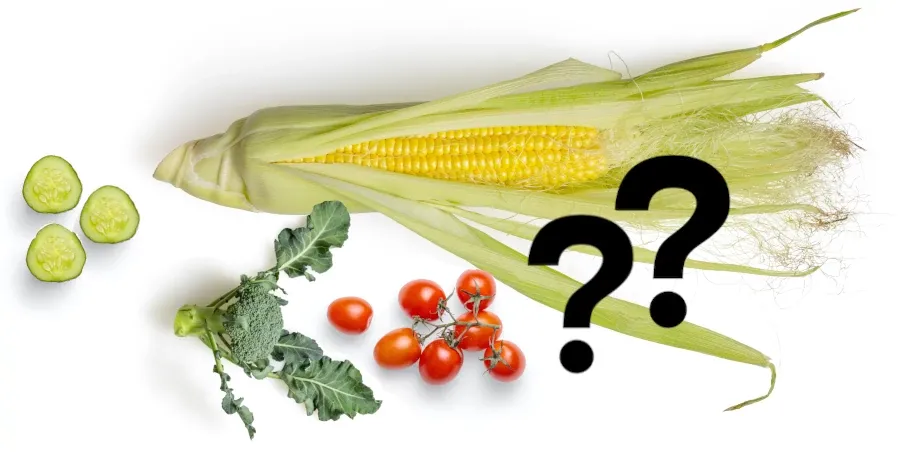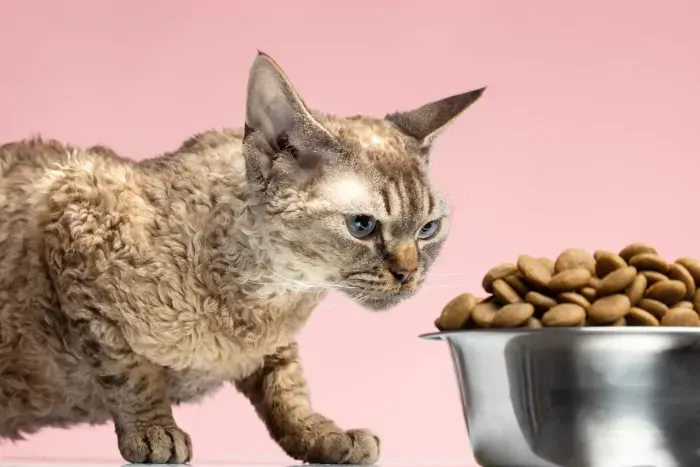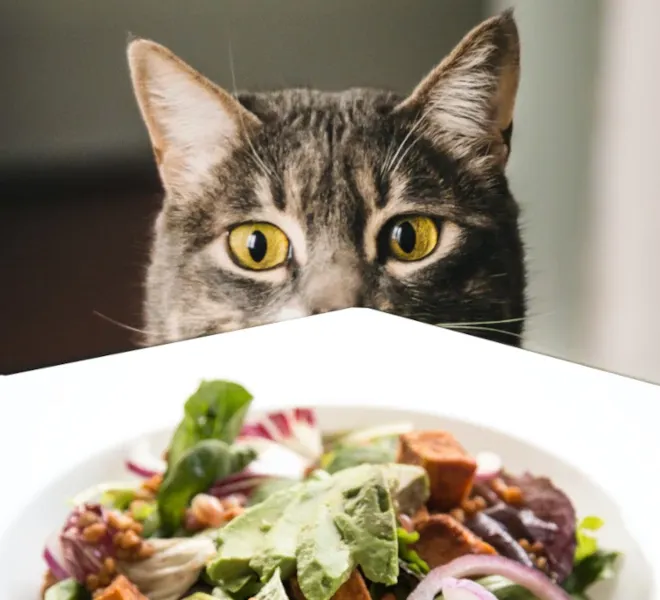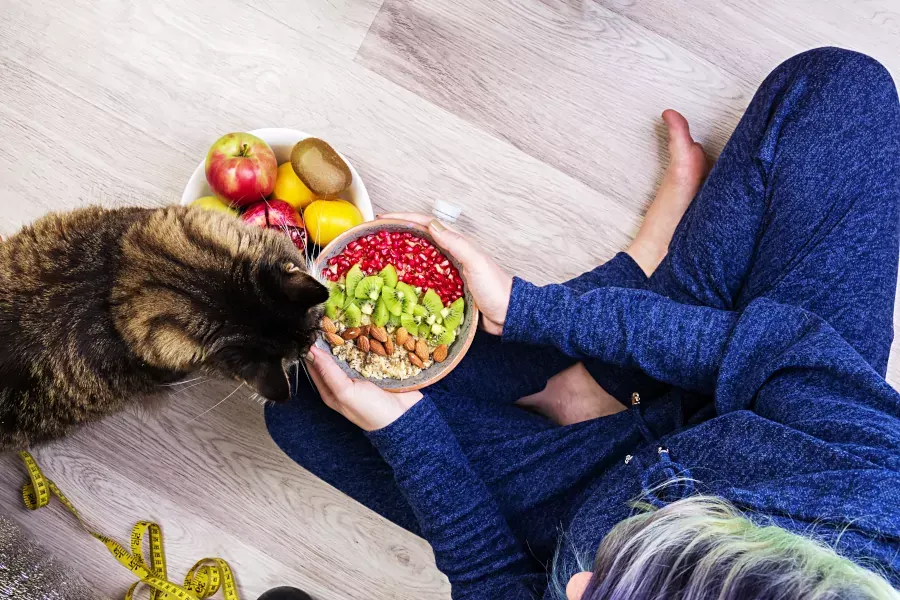Why Does My Cat Eat Vegetables?
Cats are de-programmed from eating their natural, instinctual diet. They are instead programmed to eat a variety of carnivore inappropriate plant foods used in commercial diets. Cats are so misguided that they no longer recognise their ancestral food and simply eat what is familiar to them.

When confronted with this question, one will hear all kinds of answers: "Cats love the taste" or "Vegetables are healthy for cats" and "Cats need nutrition from vegetables".
However, we are dealing with obligate or super carnivores. When looking at inappropriate food consumption in cats from a commonsense stance, one starts to see this behaviour for what it really is.
...looks can be deceiving
Despite being strict carnivores, some cats may appear to be obsessed with vegetables and fruit. But what we are seeing is not as simple as love for a food.
Consider what cats are up against. When we feed them an ultra processed commercial diet, they are meticulously programmed to eat an assortment of foods that go against their instinctual programming.
These non foods – that include plant ingredients – eventually fully replace their natural diet and form the basis of their knowledge about food.
...early food preferences
From early on, we teach kittens what to eat. Over time, these foods imprint on them and soon they will eat nothing else.
Eventually they develop a preference for these foods – even if they go against their carnivore physiology.
...lack of choices
Cats in our homes do not have many food options. They can hunt in environments fraught with danger – busy roads, intolerant people, dogs and territorial cats. Or, they can eat what we give them. Or go hungry.

It's almost easiest to just fully resign to what we feed them. We love our cats and don't want to harm them, but acceptance of inappropriate food is what inadvertently happens.
The only other cats on the planet that eat foods this far removed from their natural diet, are stray and abandoned cats that scavenge on household garbage to stay alive 1.
Cats in the wild never feed on plant foods, yet house cats come to appreciate them as a large part of their diet, even if they are damaging to their health.
...commercial food trickery
Cats foods are carefully engineered to be highly palatable and to hit all the right notes. It masks inappropriate ingredients and make them appealing – otherwise cats would not even have looked at them 2.
Aromatic, pungent digests and fats are sprayed on food to make it irresistible. Once tricked into eating non foods, cats become addicted to carbohydrates, salt and sugar – much like we get hooked on junk food.
...a powerful addiction
Those of us in the clutches of a junk food addiction can attest to the hold these foods have over us. What chances do cats have to not become addicted to ultra processed food, fed to them day after day?
Why is Commercial Cat Food So Bad? takes a closer look at more tricks of the trade that sets inappropriate food selection into motion – sometimes for life. It also looks at the health implications these foods have and offers viable solutions.
...the hunter's exquisite nose
A cat’s nose is 14 times more sensitive than a human’s 3. They rely on their acute sense of smell for survival – gathering information from their environment, locating mates and determining territories.
Locating food forms a huge part of a carnivore’s life. In our homes, they use their keen noses to ‘hunt’ for foods they recognise. And they can pick up the scent of even the smallest particles of food.
Dr David Tayman (DVM) points out that cats have an astonishing 50 to 80 million olfactory receptor cells in those cute buttons 4. Their noses will most certainly detect every ingredient used in commercial food!
And when they recognise sugars and carbohydrates, they will go after the glazed carrot on your plate. As facultative, opportunistic hunters, they seize every opportunity to 'hunt'.
When they recognise vegetables and fruit around the home, they will want them. And if one plant food resembles another, you can be sure that they will sample them.
...the misplaced hunter
Cats are innately programmed to hunt. Eating behaviour – effectively killing and dissecting – is learnt from their mother.
Even though they become de-programmed to recognise prey as food, they still retain their hunting instinct.
Even indoor cats will give chase, but will mostly fail to recognise that what they have caught is food. They end up playing with prey until they escape or die, which is distressing to witness.
Yet, we are still dealing with highly successful, intelligent – albeit misguided – hunters. As such, it goes against a cat’s nature to passively leave their feeding up to us all of the time.
They now hunt in a new way – for whatever food they recognise around our homes.

...inappropriate food programming is resistant to change
In 2023, my own three cats had been on a species appropriate diet for eight years. But two of them continue to go after inappropriate food from their environment.
They will even seek out bits of bread and rice dropped by birds in the garden.
They continue to show interest in pungent foods and carbohydrates, food aspects that were deeply imprinted on them by commercial food.
...interest in inappropriate foods may never be extinguished
When cats on a species appropriate diets grab vegetables or fruit, what we are witnessing are the lingering remnants of incorrect food programming – coupled with opportunistic ‘hunting’ behaviour.
They are not grabbing foods purely because they love them. They do so because they are familiar, accessible and cats are likely still addicted to many of them – even long after they have been removed from their diet.
...other behavioural drivers
Some cats are fed the same food – day in, day out. Many are driven by the sheer monotony of their diet to go looking for whatever else they can find – just to experience something new and interesting.
For them it is more a matter of relieving dietary boredom, rather than loving vegetables per se. Finally, cats strongly associate us with food and can be quite relentless to get a taste of whatever we are eating.
...be careful with inappropriate foods
Cats are obligate carnivores and really have no business eating so much plant matter.
Can Cats Eat a Vegan Diet? outlines the most salient hazards from over consumption of plant foods – even those in commercial food.

Dr Teresa Manucy (DVM), suggests limiting plant foods to occasional treats – not exceeding 2% of the total diet 5. But as it is, almost all commercial foods already far exceed this margin!
The average cat food contains between 35% to 55% carbohydrates 6. So feeding cats more plant matter – fresh vegetables or fruit – is likely a bad idea.
Over time, plant rich diets place a tremendous burden on the cat’s metabolic systems and physiology 7. It eventually leads to a break-down in health – a result observed in so many cats on commercial diets 8.
...cats should eat what they were designed to eat
Keep reading as future posts will discuss health optimising foods for cats. What cats should be eating, and why. takes an introductory look at the best food for cats.
Upcoming resources will also show cat carers exactly what this optimised, species appropriate diet should look like.
The next post looks at why cats are so drawn to toxic plants.


References
1 Spotte, S. (2014). Free ranging cats: Behavior, ecology, management. Chichester, West Sussex: Wiley-Blackwell.
2 Hodgkins, E.M. (2007). Your cat: Simple new secrets to a stronger, longer life. New York: St Martin’s Griffin.
3 Syufy, F. (2019). Any cat's sense of smell Is used for all aspects of survival. In Spruce Pets. Retrieved February 23, 2022, from https://www.thesprucepets.com/sense-of-smell-552117
4 Tayman, D. (2011). Howard Pets: Whose nose is keener, cat of dog? In The Baltimore Sun. Retrieved February 10, 2022, from https://www.baltimoresun.com/bs-exho-howard-pets-whose-nose-is-keener-cat-or-dog-20110509-story.html
5 Manucy, T. (2020). Which fruits can cats eat? In PetMD. Retreived February 08, 2022, from https://www.petmd.com/cat/which-fruits-can-cats-eat
6 Verbrugghe, A. & Hesta, M. (2017). Cats and Carbohydrates: The Carnivore Fantasy? Veterinary Sciences, 4(4), 55; https://doi.org/10.3390/vetsci4040055
7 Griffiths, S. & Ruish, D. (n.d.). Evolutionary nutrition for the cat. In Club Canine. Online booklet retrieved April 29, 2015. Shortened/revised version available from http://www.clubcanine.net/ evolutionary-nutrition-cats.shtml
8 Pierson, L.A. (2016). Feeding your cat: Know the basics of feline nutrition. In Cat Info. Retrieved February 7, 2023, from http:// catinfo.org
Disclaimer
The information provided on the Bestfedcats.com website is educational and informational. We are here to give guidance on how to feed a properly balanced raw diet. We also offer advice on how to improve the diet of the modern house cat. Please note that we are not veterinarians. We are not here to give veterinary advice. Best Fed Cats will not be held responsible for any adverse reactions to your cat based on the information on our website. The health of your cat depends entirely on you. We expect you to use your knowledge of your cats, their circumstances and their health – in conjunction with a trusted veterinarian – to determine if any advice provided on this site is appropriate for your cats.

